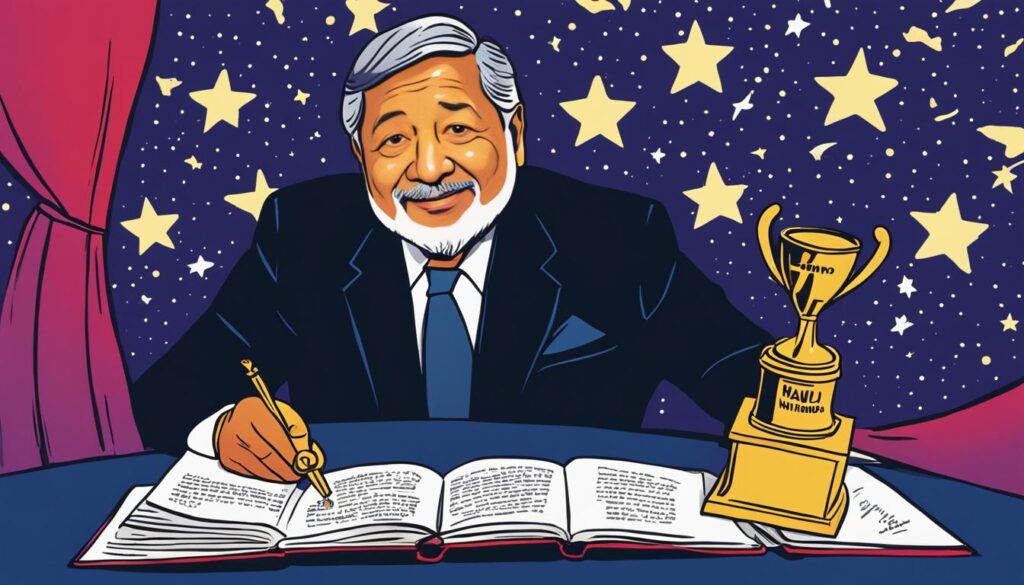In this section, we provide an overview and book summary of V.S. Naipaul’s Half a Life, a profound journey of self-discovery and identity. Half a Life is a captivating novel that explores themes such as identity, self-discovery, and cultural differences. Written by the acclaimed author V.S. Naipaul, this book follows the protagonist, Willie Chandran, on a journey from India to England and back again as he struggles to find his place in the world.
With its insightful commentary on the complexities of modern life and its eloquent prose, Half a Life has earned a reputation as one of the most significant works of modern literature. Through exploring the thoughts and experiences of Willie, Naipaul offers a profound look into the human experience, showing readers the struggles and triumphs that exist in the world around us.
In the sections that follow, we will delve into the author’s background, provide a synopsis of the story, analyze the themes, scrutinize the characters, and explore Naipaul’s writing style and language. We will also examine the critical reception and cultural and historical context of the book.
About the Author
V.S. Naipaul is an esteemed Trinidadian-British author, born in Chaguanas, Trinidad and Tobago, in 1932. He was raised in a large family of Indian descent, and his upbringing and cultural background greatly influenced his writing. Naipaul moved to England at the age of eighteen, where he pursued his studies at University College, Oxford.
Naipaul’s writing career spans over five decades, during which he authored numerous award-winning works of fiction and non-fiction, exploring themes such as identity, colonialism, and the postcolonial world. His notable works include A House for Mr Biswas, In a Free State, and The Enigma of Arrival, among others.
Aside from being a prolific writer, Naipaul was also a recipient of numerous literary honors, including the Booker Prize, the Nobel Prize in Literature, and a knighthood for his contributions to literature.
Throughout his life, Naipaul’s controversial and candid views on politics and culture have sparked both admiration and controversy. He passed away in 2018, leaving an indelible mark on the literary world and an enduring legacy of thought-provoking and insightful writings.
Synopsis of Half a Life
Half a Life by V.S. Naipaul tells the story of Willie Chandran, a man on a quest for identity and acceptance. Born in India, Willie moves to London to escape his unfulfilling life, only to find himself struggling with his place in the world.
After years of searching, Willie finds solace in Africa, where he begins a new life and embraces his true self. But just as he finds happiness, his past catches up to him, and he is forced to confront the secrets and trauma that have haunted him for half his life.
Through Willie’s journey, Naipaul explores themes of self-discovery, identity, and cultural assimilation, offering a profound commentary on the complexities of the human experience.

“Half a Life is a masterful exploration of personal and cultural identity, told with stunning prose and nuance.” – The New York Times
Themes Explored
Half a Life is a profound exploration of the search for identity and the journey of self-discovery. The protagonist, Willie Chandran, undergoes an intense transformation as he navigates the complexities of his multiracial identity.
One of the significant themes in the book is the struggle to reconcile one’s past, present, and future. Willie grapples with his Indian heritage, his English upbringing, and his desire to establish himself as an independent person. His quest for belonging and purpose leads him to travel to Africa, where he becomes engulfed in political turmoil and confronts the harsh realities of post-colonialism.
The book also explores the theme of cultural displacement and the tension that arises when one is torn between two diverging ways of life. Willie’s experiences encapsulate the struggle of many immigrants who must navigate the complex realities of living between two worlds. The entire journey serves as both a personal and political awakening that shapes Willie’s understanding of his place in the world.
“There comes a time in your life when you realize that if you stand still, you will remain at this point forever. You realize that if you fall and stay down, life will pass you by.” – V.S. Naipaul, Half a Life
Significant Themes in Half a Life
| Theme | Description |
|---|---|
| Search for identity | Willie’s struggle to understand his multiracial identity and establish his place in the world. |
| Journey of self-discovery | Willie’s exploration of his past, present, and future and the personal growth he experiences along the way. |
| Cultural displacement | The tension Willie experiences in reconciling his Indian heritage and English upbringing. |
Character Analysis
Half a Life features several captivating characters, each with their unique motivations and importance to the story’s development. Let’s take a closer look at some of the memorable characters in the book:
| Character | Description | Motivation |
|---|---|---|
| Willie Chandran | A half-Indian, half-English protagonist who embarks on a journey to find his identity and purpose in life. | To escape his mundane life in London, confront his troubled past, and search for a deeper understanding of himself. |
| Ana de Silva | A Portuguese woman whom Willie falls in love with and marries, but whose own secrets and past events haunt their relationship. | To find companionship, love, and connection, but also to escape her own complicated background and painful experiences. |
| Miriam | A South African woman who is Willie’s childhood friend and secret lover, but whose impact on his life is profound and enduring. | To cope with her own feelings of isolation and abandonment, as well as to share her intense connection with Willie. |
The characters in Half a Life all contribute to the intricate plot, exploring themes of identity, belonging, and cultural differences. Willie’s pursuit of self-discovery is central to the book, but the relationships and influences of other characters further enrich and complicate his journey.
Writing Style and Language
V.S. Naipaul’s writing style in Half a Life has been described as complex and layered, reflecting his penchant for nuance and subtlety. His use of language is considered one of his greatest strengths, often incorporating diverse influences from his own experiences and travels.
The author employs a distinctive voice and structure in Half a Life, crafting a narrative that is both introspective and probing. He skillfully blends different perspectives and timelines, creating a rich tapestry of events and emotions that add depth to the story.
Naipaul employs vivid descriptions and sensory details to bring the setting and characters to life, immersing the reader in the story’s world. His use of metaphors and other literary devices adds another layer of depth, highlighting important themes and ideas throughout the narrative.
“The only lies for which we are truly punished are those we tell ourselves.”
Writers as Observers
Naipaul’s writing style can be seen as that of an observer as he closely examines his characters and settings, illuminating their flaws and conflicts. This approach brings a level of realism and authenticity to Half a Life that resonates with readers.
The language used in the novel reflects the cultural background of the characters, adding authenticity and depth to their experiences and perspectives. From the idiosyncrasies of language to subtle nuances in cultural norms, the attention to detail in Half a Life is a testament to Naipaul’s mastery of language.
Impact on the Narrative
The complex writing style and language in Half a Life add a layer of depth and meaning to the narrative, highlighting the struggles and conflicts faced by the characters. Naipaul’s use of language and literary techniques adds to the overall impact of the story, making it a compelling and thought-provoking read.
Critical Reception and Awards
Half a Life has received widespread critical acclaim since its publication in 2001. Renowned literary critic Michiko Kakutani of The New York Times praised the novel, stating that Naipaul “demonstrates once again his mastery of irony, his keen sense of how societies operate and his knack for capturing the pathos and comedy of human experience.”
The novel was shortlisted for the 2001 Booker Prize and was a finalist for the 2002 International IMPAC Dublin Literary Award. It also received the 2001 Los Angeles Times Book Prize.

Half a Life has resonated with readers and literary enthusiasts alike, with its poignant portrayal of identity and the human experience. The novel provides a thought-provoking exploration of the complexities of life, and its critical reception and numerous awards are a testament to its lasting impact.
Cultural and Historical Context
Half a Life takes place against a backdrop of significant cultural and historical events. Set in India and Africa in the 20th century, the novel delves into themes of migration, colonialism, and racial identity.
Naipaul was renowned for his unsparing commentary on the postcolonial world, and Half a Life is no exception. In the novel, he explores the emotional and cultural conflicts of immigrants struggling to create an identity and a sense of belonging in a new land. Naipaul also examines the effects of colonialism on the colonized and explicates the complexities of cultural interaction and hybridization.
The novel portrays the serious consequences of colonialism on personal identity, family relationships, and national autonomy, depicting a world in which postcolonial subjects struggle to reconcile their allegiances to their ancestral homes with their sense of belonging to a modern, globalized society.
Historical Background
The novel is set in the mid-20th century, a period marked by significant political transformations, including India’s independence and the end of British colonial rule, as well as the emergence of African nationalisms and struggles for independence. These events had a profound influence on people’s lives and created an atmosphere in which people were struggling to find a sense of identity and belonging.
Cultural Context of Half a Life
The novel is set in India and Africa, two regions with a complex history of cultural interaction and exchange. Naipaul explores the cultural hybridization resulting from colonial encounters, as well as the struggles of immigrants to negotiate their cultural identity in the face of societal pressures and expectations. The novel contains profound insights into the complex cultural and historical contexts that underpin human experience, making it a significant work of literature that continues to exert a lasting influence on its readers.
Conclusion
Half a Life by V.S. Naipaul is a thought-provoking and compelling journey of self-discovery and identity. The book explores the human experience of grappling with individuality, belonging, and purpose, making it an essential read for anyone seeking to understand the complexities of the human psyche.
In summary, this article has provided an overview of Half a Life, explored the author V.S. Naipaul and his background, delved into the plot and themes, analyzed the characters, examined the writing style and language, discussed the literary awards and critical reception, and added context to the cultural and historical significance of the story.
After reading this article, readers can appreciate V.S. Naipaul’s masterful writing, understand the profound insights into the human psyche offered by Half a Life, and recognize the book’s cultural and literary significance. In conclusion, Half a Life is a must-read for anyone looking for a profound reflection on the human experience.



